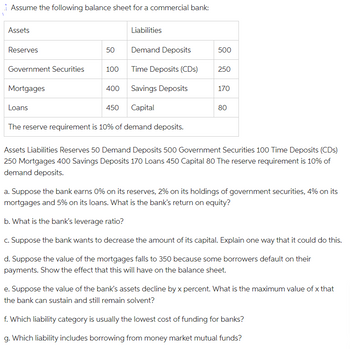
ENGR.ECONOMIC ANALYSIS
14th Edition
ISBN: 9780190931919
Author: NEWNAN
Publisher: Oxford University Press
expand_more
expand_more
format_list_bulleted
Question
need E,F,G

Transcribed Image Text:Assume the following balance sheet for a commercial bank:
Assets
Liabilities
Reserves
50
Demand Deposits
500
Government Securities
100
Time Deposits (CDs)
250
Mortgages
400
Savings Deposits
170
Loans
450
Capital
80
The reserve requirement is 10% of demand deposits.
Assets Liabilities Reserves 50 Demand Deposits 500 Government Securities 100 Time Deposits (CDs)
250 Mortgages 400 Savings Deposits 170 Loans 450 Capital 80 The reserve requirement is 10% of
demand deposits.
a. Suppose the bank earns 0% on its reserves, 2% on its holdings of government securities, 4% on its
mortgages and 5% on its loans. What is the bank's return on equity?
b. What is the bank's leverage ratio?
c. Suppose the bank wants to decrease the amount of its capital. Explain one way that it could do this.
d. Suppose the value of the mortgages falls to 350 because some borrowers default on their
payments. Show the effect that this will have on the balance sheet.
e. Suppose the value of the bank's assets decline by x percent. What is the maximum value of x that
the bank can sustain and still remain solvent?
f. Which liability category is usually the lowest cost of funding for banks?
g. Which liability includes borrowing from money market mutual funds?
Expert Solution
This question has been solved!
Explore an expertly crafted, step-by-step solution for a thorough understanding of key concepts.
Step 1: Describe the importance of banking
VIEW Step 2: Determine the maximum value of x that the bank can sustain and still remain solvent
VIEW Step 3: Explain which liability category is usually the lowest cost of funding for banks
VIEW Step 4: Explain which liability includes borrowing from money market mutual funds
VIEW Solution
VIEW Step by stepSolved in 5 steps

Knowledge Booster
Learn more about
Need a deep-dive on the concept behind this application? Look no further. Learn more about this topic, economics and related others by exploring similar questions and additional content below.Similar questions
arrow_back_ios
SEE MORE QUESTIONS
arrow_forward_ios
Recommended textbooks for you

 Principles of Economics (12th Edition)EconomicsISBN:9780134078779Author:Karl E. Case, Ray C. Fair, Sharon E. OsterPublisher:PEARSON
Principles of Economics (12th Edition)EconomicsISBN:9780134078779Author:Karl E. Case, Ray C. Fair, Sharon E. OsterPublisher:PEARSON Engineering Economy (17th Edition)EconomicsISBN:9780134870069Author:William G. Sullivan, Elin M. Wicks, C. Patrick KoellingPublisher:PEARSON
Engineering Economy (17th Edition)EconomicsISBN:9780134870069Author:William G. Sullivan, Elin M. Wicks, C. Patrick KoellingPublisher:PEARSON Principles of Economics (MindTap Course List)EconomicsISBN:9781305585126Author:N. Gregory MankiwPublisher:Cengage Learning
Principles of Economics (MindTap Course List)EconomicsISBN:9781305585126Author:N. Gregory MankiwPublisher:Cengage Learning Managerial Economics: A Problem Solving ApproachEconomicsISBN:9781337106665Author:Luke M. Froeb, Brian T. McCann, Michael R. Ward, Mike ShorPublisher:Cengage Learning
Managerial Economics: A Problem Solving ApproachEconomicsISBN:9781337106665Author:Luke M. Froeb, Brian T. McCann, Michael R. Ward, Mike ShorPublisher:Cengage Learning Managerial Economics & Business Strategy (Mcgraw-...EconomicsISBN:9781259290619Author:Michael Baye, Jeff PrincePublisher:McGraw-Hill Education
Managerial Economics & Business Strategy (Mcgraw-...EconomicsISBN:9781259290619Author:Michael Baye, Jeff PrincePublisher:McGraw-Hill Education


Principles of Economics (12th Edition)
Economics
ISBN:9780134078779
Author:Karl E. Case, Ray C. Fair, Sharon E. Oster
Publisher:PEARSON

Engineering Economy (17th Edition)
Economics
ISBN:9780134870069
Author:William G. Sullivan, Elin M. Wicks, C. Patrick Koelling
Publisher:PEARSON

Principles of Economics (MindTap Course List)
Economics
ISBN:9781305585126
Author:N. Gregory Mankiw
Publisher:Cengage Learning

Managerial Economics: A Problem Solving Approach
Economics
ISBN:9781337106665
Author:Luke M. Froeb, Brian T. McCann, Michael R. Ward, Mike Shor
Publisher:Cengage Learning

Managerial Economics & Business Strategy (Mcgraw-...
Economics
ISBN:9781259290619
Author:Michael Baye, Jeff Prince
Publisher:McGraw-Hill Education